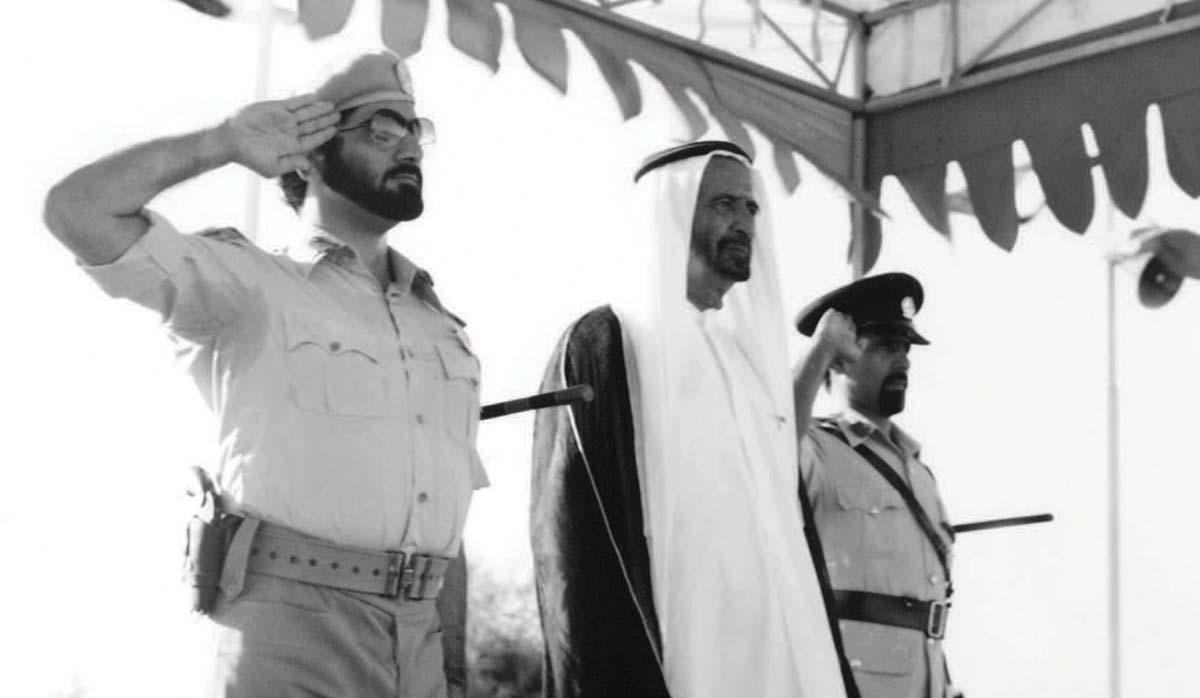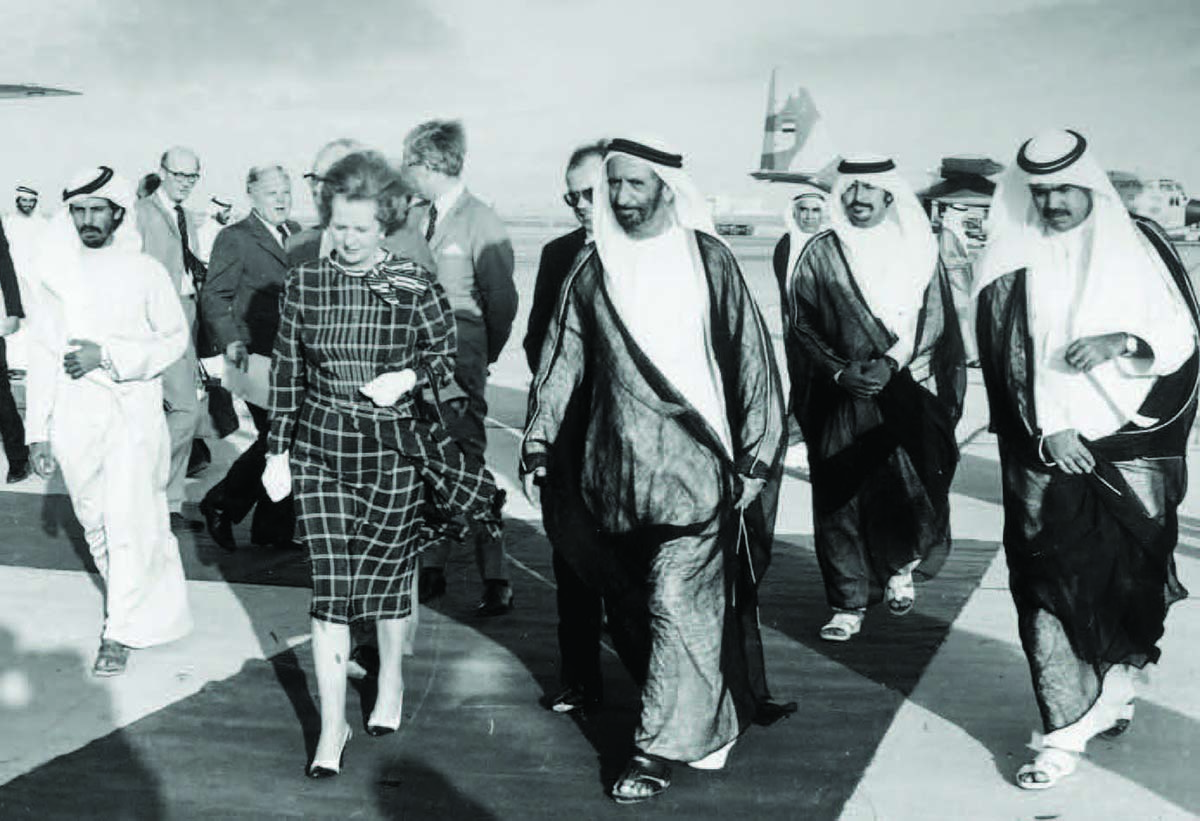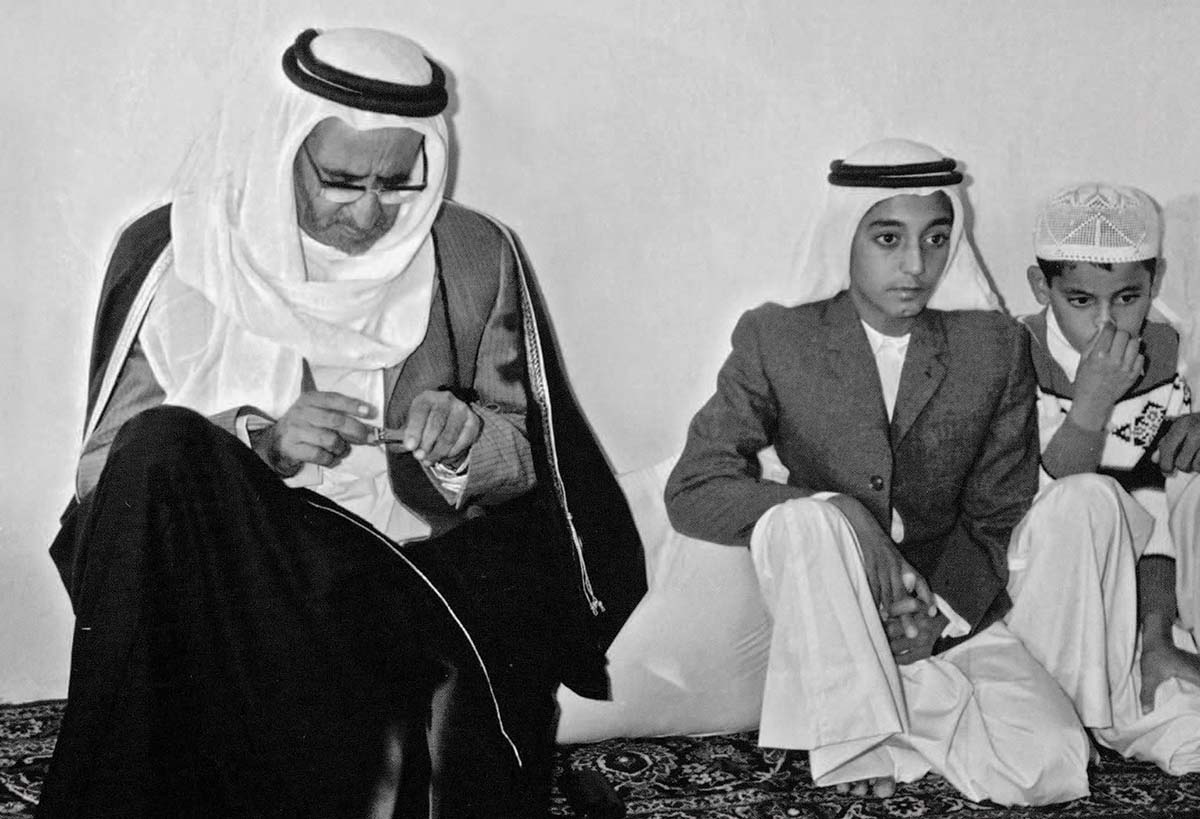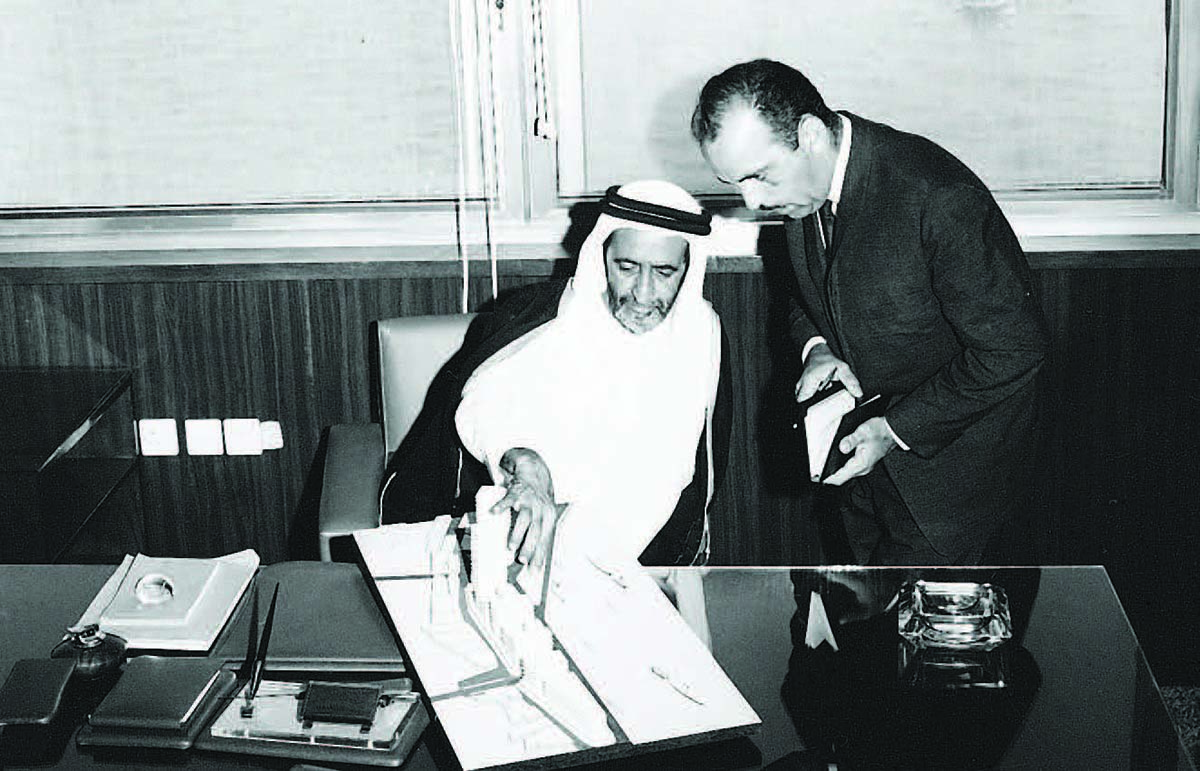
Sheikh Rashid bin Saeed Al Maktoum
Full name: Sheikh Rashid bin Saeed bin Maktoum bin Hasher bin Maktoum bin Butti bin Suhail Al Maktoum Al Falasi
Born: 1912
Died: 1990
Duration of rule: 32 years
Birth and upbringing

Various sources disagree on the actual date of birth of the late Sheikh Rashid bin Saeed Al Maktoum (may his soul rest in peace) but it is likely that he was born in 1912. He grew up in Al Shindagha neighbourhood. His father, Sheikh Saeed bin Maktoum Al Maktoum, was known for his piety, wisdom, patience and prudence. His mother, Sheikha Hessa bint Al Mur bin Hureiz Al Falasi, was popularly known as Umm Dubai (Mother of Dubai) and she enjoyed a special place in the hearts of the people in the Emirate. Sheikha Hessa was resolute, strong-willed and ambitious, and was renowned for her generosity, philanthropy and help extended to the needy. Sheikha Hessa had a clear impact on the personality of her son, Sheikh Rashid.
Education
Sheikh Rashid received his first education at a katateeb (a traditional school) as the area lacked formal schools. There he learnt the principles of Islamic jurisprudence and Arabic language. When formal education began with the opening of Al Ahmadiya School, Sheikh Rashid was one of the first pupils to be enrolled. From a young age, he showed maturity and his thinking was ahead of his time. He was known as a diligent young man who had an inquisitive mind.
Hobbies
Some of Sheikh Rashid’s hobbies were falconry, archery and camel and horse riding.
Character
Simplicity and spontaneity were the prominent traits of Sheikh Rashid’s personality, which distinguished him from many other leaders. He led a simple life in all aspects. Foreigners were often surprised to see a leader of his stature exhibiting such humility.
However, he had a visionary outlook that helped shape the modern identity of Dubai, laying the foundation for its transformation into one of the world’s most advanced cities.
His Highness Sheikh Mohammed bin Rashid Al Maktoum, Vice President and Prime Minister of the UAE and Ruler of Dubai, recalls his father saying: “I am building Port Rashid because a day may come when you cannot afford to build it.”
“No one before my father considered such a project, but he did,” said HH Sheikh Mohammed bin Rashid Al Maktoum. “How did he envision it? I do not know a brief answer, but if I had to sum it up in one word, it would be vision.”

The beginnings of a life of service
Sheikh Rashid was involved in politics from a young age as the eldest son of Sheikh Saeed. He regularly attended his father’s gatherings and showed keen interest in the discussions, listening attentively to the ideas and opinions expressed. He would often accompany his father for long hours, asking him about every event he witnessed or heard of, engaging in discussions and valuing the perspectives of others.
By the age of 18, he had already become deeply involved in the governance of Dubai during his father’s rule, and began to handle important matters from 1938.
Approach

During his rule, Sheikh Rashid adhered to a systematic and unique approach, closely following up on projects through daily schedules. He conducted two daily rounds of Dubai, personally overseeing the progress of projects.
These daily rounds provided him with an opportunity to meet the general public, listen to their concerns and respond to their needs. After returning from his rounds, he would spend considerable time presiding over his council – a forum where people could meet him, share their issues and have their demands addressed.
Sheikh Rashid devoted significant attention to his council, where he patiently listened to all opinions and grievances, ensuring the best solutions were put forward for the problems of the day, and ensuring that help was provided to everyone. The council brought together people from diverse nationalities, fostering a base for constructive dialogue. It featured trusted advisers.
Responsibility
Sheikh Rashid had regularly attended his father’s majlis (court), from which he immensely benefitted as he learnt how to run the affairs of the state. He kept abreast of all the proceedings and activities of the majlis to learn how to run the government and how to shoulder the enormous responsibility upon becoming Ruler. In 1939, he was appointed Crown Prince and he helped his father run the state, demonstrating his ability to assume responsibility.

Vision
Sheikh Rashid possessed a forward-looking vision that contributed to the comprehensive development of Dubai, as well as the growth of the federation after 1971. He knew how to choose the right time to implement plans, executing every development plan with careful timing. His encouragement of dedicated and hardworking officials motivated them, leading to a distinctive development journey that is key to Dubai’s success. His innovative and ambitious thinking made Dubai a global beacon, and the Emirate’s journey to development and prosperity was closely tied to Sheikh Rashid, a distinctive leader in Arab history.

Saving Dubai
Sheikh Rashid was able to save Dubai from several economic crises, with the most notable caused by the decline of pearl trade and a maritime blockade that Britain imposed on Arab Gulf ports after the Second World War.

Accession and style of government
In 1958, after the death of Sheikh Saeed, Sheikh Rashid assumed the reins of government in Dubai, which he ruled for 32 years, during which the Emirate witnessed rapid growth in all fields.
Sheikh Rashid and his family then moved to his father’s palace in Zaabeel. From the moment he assumed power, he made sure to establish Dubai as a commercial hub, especially given that oil revenue then was hardly sufficient to meet the Emirate’s obligations. Hence, he looked after markets, supported businessmen, encouraged commercial investment in the Emirate and devised a long-term plan and a futuristic vision for the city of Dubai. He was interested in establishing government departments that provide services to the people and contribute to the development of the Emirate. These included the municipality, land, police, customs, electricity and water departments, as well as courts of law.

Union
The union of the UAE was one of Sheikh Rashid’s significant ideas, merging with the aspirations of his late brother and fellow Founding Father Sheikh Zayed bin Sultan Al Nahyan. They worked hand in hand to build the nation, solidify the Union and achieve progress and prosperity for citizens.
Sheikh Rashid played a crucial role in the UAE’s foundation, sharing a vision with fellow Rulers of the Emirates who valued the importance of a federation. On July 10, 1971, he invited others to advance on the path to unity, culminating in the official union on December 2, 1971, where he held the positions of Vice President and Prime Minister.
All resources were mobilised for the country’s development, providing citizens with a dignified life, driven by the people’s trust in their wise and visionary leadership.
A distinguished teacher and father
Sheikh Rashid remains an inspiring and influential figure, an icon of success and a great role model for future generations. He is a venerable figure, inspiring lessons in development and nation-building. In his book My Story, HH Sheikh Mohammed bin Rashid Al Maktoum said: “Rashid bin Saeed’s lessons never end. He was a school, a teacher, a ruler and a father to all.”
He added: “From Rashid, I learned from a young age that a leader is the most active person, capable of executing projects with high efficiency. I learned that every dirham in Dubai has great value and is spent only in the right place. Rashid bin Saeed instilled a governance culture of prudent spending, avoiding any form of governmental extravagance.”
Passing
On October 7, 1990, Sheikh Rashid passed away, leaving a broad legacy of planning and execution that guided Dubai’s continued development.
News of his death spread globally, and Dubai, mourning the loss of its beloved Ruler, received condolences on the passing of this unique leader.
His death left a profound impact worldwide as his achievements made him a celebrated figure, and his accomplishments elevated Dubai to unprecedented levels of development.
The Birth and upbringing of Sheikh Rashid

Various sources disagree on the actual date of the birth of the late Sheikh Rashid Bin Saeed Al Maktoum, May his soul rest in peace, but it is likely that he was born in 1912. He grew up in Al Shandagha neighborhood and raised by his father Sheikh Saeed Bin Maktoum Al Maktoum, who is known for his piety, wisdom, patience and forethought. Sheikh Rashid closely watched the wise policies of his father, Sheikh Saeed Bin Maktoum by attending his Majlis, where he benefited from his father’s pure democratic views that comes from the original Islamic principles of “Shura” and the Bedouin traditions. His mother Sheikha Hessa Bint Al Mur Bin Hureiz Al Falasi; who was popularly known as Um Dubai “Mother of Dubai” played a vital role in influencing Sheikh Rashid’s personality. Sheikha Hessa had a clear impact on her son and in preparing him to rule Dubai.
Sheikh Rashid received his first education at katateeb (a traditional school that teaches Arabic and Islamic jurisprudence principles), as the area then lacked formal schools. At the beginning of the formal education in Dubai and the opening of Al Ahmadiya School, Sheikh Rashid was one of the first students to be enrolled. From a young age, he was mature and his thinking was ahead of his time. He was known as a diligent young man who had an inquisitive mind. Falconry, horseback and camel riding and shooting were some of his most cherished hobbies.
The First Beginnings

Sheikh Rashid had regularly attended his father’s Majlis (court) from which he immensely benefitted as he learnt how to run the affairs of the state; he kept abreast of all the proceedings and activities of the Majlis, which helped him to learn how to run the government and how to carry the responsibility after his father. In 1939, Sheikh Rashid was appointed Crown Prince of Dubai. He helped his father run the state, and demonstrated his ability to assume responsibility. He was able to save Dubai from several economic crises, notably the decline of pearl trade and the maritime blockade, which Britain imposed on the Arab Gulf ports after World War II. In 1958, he assumed the reins of government in Dubai, which he ruled for 32 years during which the Emirate witnessed rapid growth in all fields.
After World War II, Dubai resumed oil excavation operations. Sheikh Rashid, negotiating on behalf of his father, managed to raise the share split between the government and oil exploration companies from 20%, as it used to be up to 50%. After failed attempts to discover oil onshore, oil was discovered offshore in what was to be named the ‘Fateh’ offshore oil field in 1966. Sheikh Rashid used the revenues generated from the oil industry to invest in the infrastructure of the emirate. Schools, hospitals and roads were of high importance followed by setting up modern communications and transportation networks. During the reign of Sheikh Rashid, the Dubai International Airport was built to handle all sorts of different aircrafts. Plans were also set to build the largest man-made port in the world at Jebel Ali.
Since Sheikh Rashid assumed power in Dubai, he made sure to establish it as a commercial hub, especially that oil revenues then were hardly sufficient to meet the Emirate’s obligations. Hence, he looked after the markets, supported businessmen, encouraged commercial investment, and devised a long-term plan and a futuristic vision for Dubai. Sheikh Rashid was interested in establishing government departments that provide services to the people and contribute to the development of the Emirate, such as the municipality, the land Department, the police, the Customs, the Electricity, and the Water, beside other departments.
The Builder of Dubai Renaissance

Sheikh Rashid was a politician and had good brotherly relations with all the Rulers of the Arabian Gulf. He was also a distinctive economist who laid the cornerstone for modern Dubai and paid attention to construction and commerce. He harnessed all resources for his country’s benefit, as the commercial production of Dubai oil began in 1966. For this purpose, Sheikh Rashid established the Department for Oil Affairs, as well as Judicial, and Aviation Departments.
Dubai was undergoing a real transformation. Sheikh Rashid broadened and deepened the creek, as its shallow water posed a threat to navigation and made it hard for large vessels to enter it. The deepening project was accomplished, and Dubai Creek became one of the best commercial and economic harbors in the region. In 1962, Al Maktoum Bridge, which spanned the Creek, was constructed joining Dubai with Deira and eliminating the long trip around the head of the Creek.
The Distinctive Economist

Driven by his futuristic vision, Sheikh Rashid accomplished what many believed to be impossible. Projects viewed as impossible by many members of society, including foreigners, were seen as challenges by Sheikh Rashid.
In October 1972, Port Rashid was inaugurated. It was a huge harbor that underpinned the economy of the Emirate of Dubai in particular and the UAE in general. Sheikh Rashid encouraged businesses and businessmen. He aspired to increase his state resources and encouraged international shipping lines to come to Dubai. Thus, it became a commercial centre between East and West.
Sheikh Rashid also saw an industrial port as essential part of that concept and a key to Dubai’s development and industrialisation. He personally chose Jebel Ali as the location for his new supersized port and even conceived an outline concept before involving his advisers in planning, financing and constructing what was to become one of the world’s major ports.
Sheikh Rashid’s hands-on approach called for a disciplined daily schedule. He would tour Dubai twice daily to see for himself how the projects were progressing. Sheikh Rashid was never satisfied with simple explanations or short answers; instead, he wanted to have a detailed understanding of every project undertaken in Dubai.
A Futuristic Vision that became A Reality

A stamp issued in Dubai in November 1964 to mark the international outer space achievements brought into focus the foresight of the late Sheikh Rashid Bin Saeed Al Maktoum, the Father of Dubai.
Sheikh Rashid wanted to commemorate the American astronauts' first trip to outer space, by issuing a stamp under the theme 'Honouring Astronauts', which made headlines later when HH Sheikh Mohammed bin Rashid Al Maktoum, Vice President and Prime Minister of the UAE and Ruler of Dubai, mentioned it on Twitter on the occasion of the UAE Space Agency's second anniversary, to show that Sheikh Rashid’s ambitions and his futuristic foresight about Dubai became a reality, and to emphasise that Sheikh Rashid’s thoughts were ahead of his time.
Internal policy

In 1924 Sheikh Rashid reached the age of 12, where his strong personality became obvious to others, who also touched his strong charisma and dignity, further to his humbleness which forced others to respect and appreciate him, especially to appreciate his seriousness, honesty, knowledge and political superiority.
When Sheikh Rashid assumed power in Dubai, he used to return home in the evening after his tour around the city, to take on more official business and to attend his traditional evening Majlis, where the Ruler gives his people the opportunity to meet him and share their problems or grievances with him. Sheikh Rashid took this duty very seriously. He was admired for his patience on these occasions; he thoughtfully considered each man’s complaint or opinion, ensuring that proper assistance was given to each individual.
The Majlis also provided a vibrant stage for discussion. Surrounded by men whose opinions he valued, projects were dissected, moulded, and often implemented by members of the Majlis. Determined in his unfaltering belief that a modernised Dubai could be achieved, Sheikh Rashid initiated numerous remarkable developments in his city-state.
Federal Union between Dubai and Abu Dhabi

After the late Sheikh Zayed bin Sultan Al Nahyan became the Ruler of Abu Dhabi in 1966, he had a vision of creating a union to catalyse development just as the other developing nations. Sheikh Rashid bin Saeed Al Maktoum, who was Dubai’s Ruler since 1958, had a similar vision. A shared vision between the two leaders translated into a federal union between Dubai and Abu Dhabi after the historical meeting in Seih Al Sedira, located on the border area between both emirates, and announcing the signing of the Federation Agreement on 18th February 1968.
The foundation of the United Arab Emirates

The Dubai-Abu Dhabi Federal Union opened new doors for the establishment of a wider union driven by the shared vision of both Sheikh Zayed and Sheikh Rashid. Ultimately, and after hard work of communications and negotiations, on 18th July 1971, six of the Trucial States (Dubai, Abu Dhabi, Sharjah, Ajman, Umm Al Quwain and Fujairah) decided to form a state under one banner. On 2nd December 1971, the establishment of the United Arab Emirates was announced. Ras Al Khaimah joined the union on 2nd December 1972 when the late Sheikh Zayed bin Sultan Al Nahyan raised the UAE flag for the first time.
Most Important Achievements after the Federation

Opening of Port Rashid in 1972
Opening of Al Shindagha Tunnel in 1975
Opening of Jebel Ali Port in 1979
Inauguration of Dubai World Trade Center in 1978
Dubai Creek second major excavations and widening in early 1970s
Inauguration of Dubai Dry-docks in 1983
The Death of Sheikh Rashid bin Saeed Al Maktoum

In his book “My Story… 50 Memories from Fifty Years Of Service”, His Highness Sheikh Mohammed bin Rashid Al Maktoum, Vice President and Prime Minister of the UAE and Ruler of Dubai, wrote about the death of his father, the late Sheikh Rashid bin Saeed Al Maktoum stating: “At 10 am on Sunday, October 7, 1990, Sheikh Rashid's soul returned to its maker and he left this world gently and peacefully. Hearts mourned his death, tears were shed. Many did not believe that Rashid, who had been a father to them for over three decades, was dead. The death of a father is perhaps the most difficult death to accept.”
“In New York, the United Nations General Assembly stood in silence for a minute in mourning of Sheikh Rashid, and the news of his death was widely broadcast, along with all of his achievements- principally in creating the economic and development miracle that is Dubai.”
“When I saw the tears in the eyes of the humble labourers, I realised that Sheikh Rashid had touched the hearts of everyone, and that his morning walks and tours were not limited to visiting projects, but were also to visit the public. His mark is found on every stone, in every corner of Dubai, whose construction he personally supervised, so that his legacy shall remain forever alive in the memory of his nation and his people.”
In mourning for Sheikh Rashid, Sheikh Zayed said: “He was one of this country’s benevolent men... one of its brave knights, and one of the pioneers of its unity and builders of its civilisation. His demise does not mean that he has left our memory or our lives. He will always stay in our hearts and remain in the forefront of those who made history in this country.”








